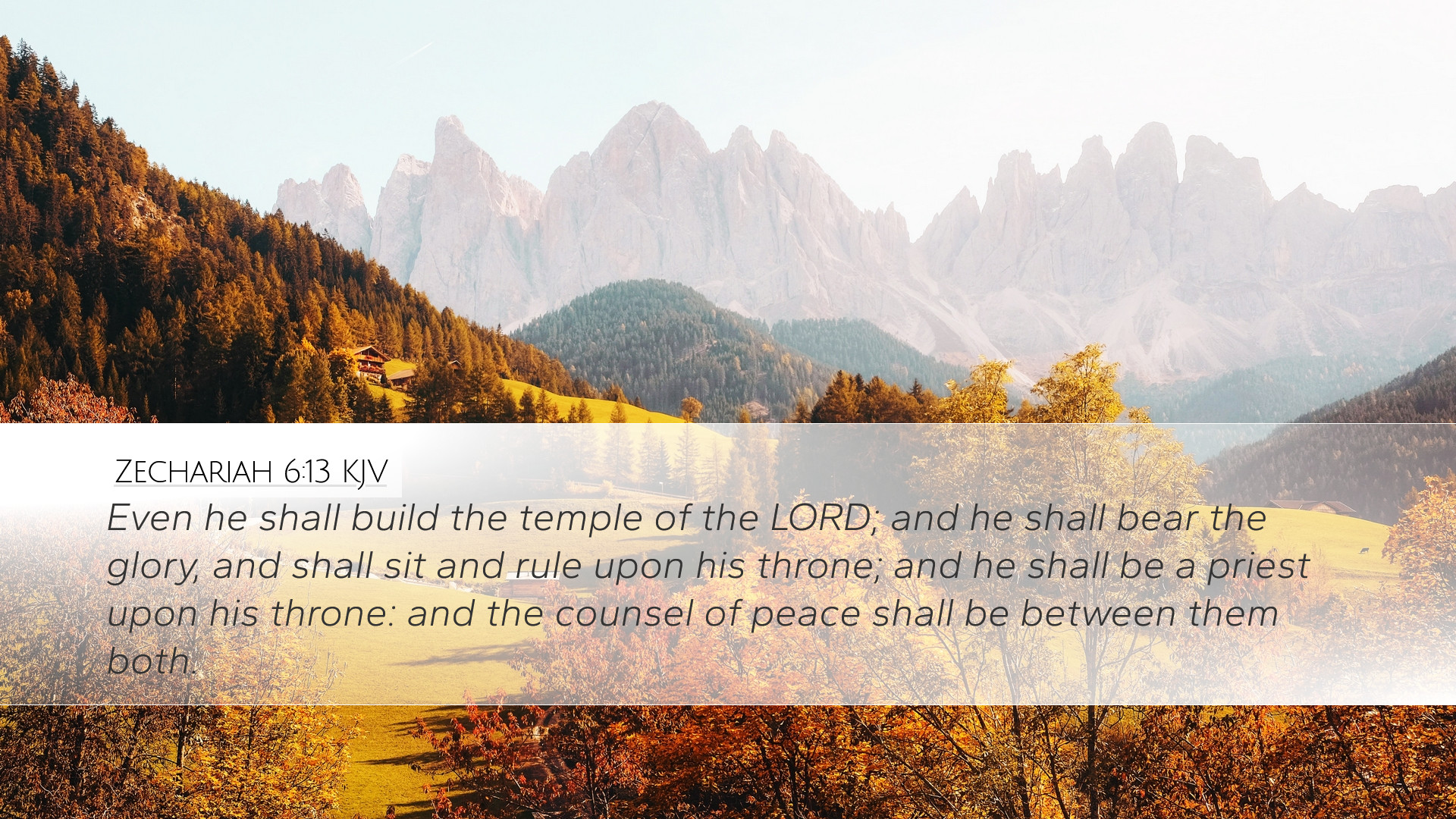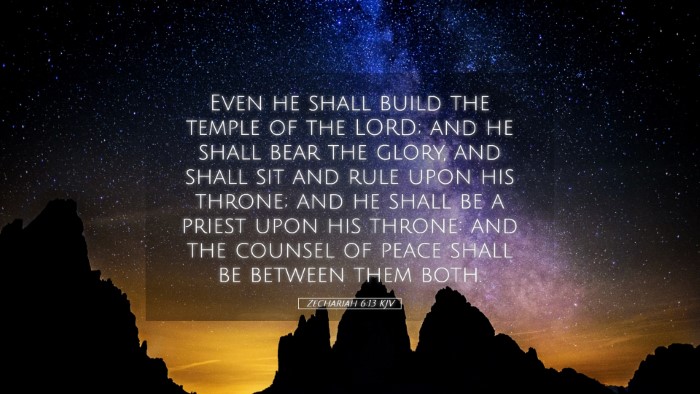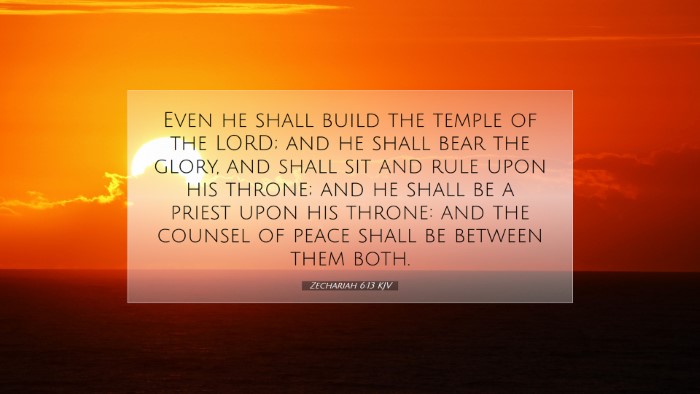Old Testament
Genesis Exodus Leviticus Numbers Deuteronomy Joshua Judges Ruth 1 Samuel 2 Samuel 1 Kings 2 Kings 1 Chronicles 2 Chronicles Ezra Nehemiah Esther Job Psalms Proverbs Ecclesiastes Song of Solomon Isaiah Jeremiah Lamentations Ezekiel Daniel Hosea Joel Amos Obadiah Jonah Micah Nahum Habakkuk Zephaniah Haggai Zechariah MalachiZechariah 6:13
Zechariah 6:13 KJV
Even he shall build the temple of the LORD; and he shall bear the glory, and shall sit and rule upon his throne; and he shall be a priest upon his throne: and the counsel of peace shall be between them both.
Zechariah 6:13 Bible Commentary
Commentary on Zechariah 6:13
Verse: "Even he shall build the temple of the Lord; and he shall bear the glory, and shall sit and rule upon his throne; and he shall be a priest upon his throne: and the counsel of peace shall be between them both."
Introduction
The prophecy of Zechariah is deeply rooted in Israel's restoration following the Babylonian exile. Chapter 6 presents a vision that not only signifies God’s intention to restore Israel, but also to reveal the coming Messiah who would fulfill both priestly and kingly roles. This commentary synthesizes insights from noted public domain theologians like Matthew Henry, Albert Barnes, and Adam Clarke to expound upon the profound implications of Zechariah 6:13.
Contextual Analysis
In seeking a proper understanding of Zechariah 6:13, it is essential to consider its context. Zechariah is a post-exilic prophet who addresses a new generation striving to rebuild their nation and temple. His visions serve to encourage the people and establish a sense of hope as they navigate the challenges ahead.
The Coming Priest-King
This verse introduces an astonishing blend of leadership roles as it speaks of a figure who will build the temple, bear glory, and function as both king and priest. The duality of these offices is significant. In ancient Israel, kings and priests were separate; however, this prophecy points toward the Messiah who is both. The fulfillment is attributed to Jesus Christ, who embodies these roles as articulated by Matthew Henry:
“He is both King of kings and the High Priest of our profession, standing as our mediator and ruling with sovereign authority.”
The Significance of Building the Temple
Building the temple: The act of building is not merely physical construction but represents the establishment of a new covenant community. Albert Barnes presents an insightful interpretation:
“Alluding to the spiritual temple, the Church of Christ, which he builds up in the hearts of believers as living stones.”
This understanding broadens the scope of the verse beyond a physical restoration to signify an enduring spiritual reality.
The Majesty of His Glory
The text states that He "shall bear the glory." Adam Clarke elaborates that this denotes a divinely orchestrated splendor that accompanies the rule of the Messiah.
“The glory here alluded to is the visible manifestation of God's presence, illustrated throughout Scripture as vital for Israel's identity and mission.”
This glory confirms that the authority and reign of Christ are rooted in divine approval and empowerment. It also serves as a source of inspiration for those serving within the Church today.
Royal and Priestly Rule
The phrase “shall sit and rule upon his throne” emphasizes stability and authority. It reflects the Messianic promise wherein Jesus rules not just in heaven but manifests His reign in the lives of believers. Clarke states:
“Christ's throne is not solely a place of authority but signifies His active engagement in the administration of grace and justice.”
The Priesthood of Christ
Next, the text refers to Him as “a priest upon his throne.” Therein lies a radical shift from the Levitical priesthood to the eternal priesthood of Christ. Matthew Henry remarks:
“He combines the royal and priestly functions, ensuring that His mediating work is both authoritative and compassionate.”
This aspect encourages believers to approach the throne of grace with confidence, as they are assured of their High Priest's intercession.
The Counsel of Peace
Finally, the phrase “the counsel of peace shall be between them both” points to the harmony between the kingly and priestly functions of Christ. As Albert Barnes explains:
“It indicates that the reign of Christ is characterized by peace and reconciliation, fulfilling the prophetic vision of Isaiah 9:6 regarding the Prince of Peace.”
This brings to light the essential nature of Christ’s ministry: to restore peace between God and humanity, a theme echoed throughout the New Testament.
Conclusion
Zechariah 6:13 encapsulates profound truths about Jesus as the Priest-King who fulfills the roles of builder, ruler, and intercessor. Through evaluating the insights of notable theologians, we recognize the implications for worship, service, and the hope we hold in Christ. As the Church builds upon this prophetic foundation, it is encouraged to participate in Christ's divine mission with faith and expectation.
In a world where uncertainty reigns, the assurance of Christ's peaceful rule and priestly intercession provides a sanctuary for all who seek refuge in Him.


